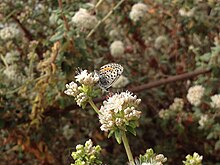El Segundo blue
| El Segundo blue | |
|---|---|

| |
| Scientific classification | |
| Domain: | Eukaryota |
| Kingdom: | Animalia |
| Phylum: | Arthropoda |
| Class: | Insecta |
| Order: | Lepidoptera |
| Family: | Lycaenidae |
| Genus: | Euphilotes |
| Species: | E. allyni
|
| Binomial name | |
| Euphilotes allyni O. Shields, 1975
| |
| Synonyms | |
| |
The El Segundo blue (Euphilotes allyni) is an endangered species of butterfly. It is endemic to a small dune ecosystem in Southern California that used to be a community called Palisades del Rey, close to the Los Angeles International Airport (LAX).[2]
Taxonomy
[edit]It was originally thought to be a subspecies of the square-spotted blue (E. battoides) or the Bernardino blue (E. bernardino), but recent authorities consider it its own species.[3][4]
Conservation
[edit]In 1976 it became a federally designated endangered species.[5] This butterfly’s habitat has been substantially reduced due to urban development and invasive plants, and it now exists as a handful of populations restricted to coastal dunes in the vicinity of Los Angeles.[6]
Distribution and habitat
[edit]The El Segundo Blue Butterfly Habitat Preserve next to LAX exists to protect the subspecies. Until 2013, there are only three colonies of this tiny butterfly still in existence. The largest of these is on the grounds of LAX; a further colony exists on a site within the huge Chevron El Segundo oil refinery complex,[7] and the smallest colony is an area of only a few square yards on a local beach. In 2013, the El Segundo blue was discovered living and breeding in the Ballona Wetlands,[8] and its range now extends south to the Palos Verdes Peninsula and some have been located in Santa Barbara County.[9] The butterfly lays its eggs on Seacliff buckwheat (Eriogonum parvifolium), which the adults also use as a nectar source. This is its host plant. Recently, some nearby beach cities such as Redondo Beach have replaced ice plant growth near the beaches with coast buckwheat, in order to provide the butterflies with more of their natural food source.
See also
[edit]References
[edit]- ^ "NatureServe Explorer 2.0".
- ^ Ohanesian, Liz (July 15, 2021). "This Tiny, Blue Butterfly Is in Trouble. Local Conservationists Are Fighting to Change That". Los Angeles Magazine.
- ^ Davenport, K. 2018. Lepidoptera of North America 15. Butterflies of southern California in 2018: updating Emmel and Emmel's 1973 Butterflies of southern California. Contributions of the C.P. Gillette Museum of Arthropod Diversity Colorado State University, Fort Collins, Colorado. 175 pp.
- ^ Rubinoff, D., T. Longcore, J.R. Dupuis, and K.H. Osborne. 2021. Genomic data support the elevation of the federally listed El Segundo Blue (Euphilotes bernardino/battoides allyni) to species status. Journal of the Lepidopterists' Society 75(2): 161-164.
- ^ Traci Watson:Rare Butterflies Flying High at Los Angeles Airport, National Geographic, 21 April 2016
- ^ Dupuis, Julian (2020). "Genomics Confirms Surprising Ecological Divergence and Isolation in an Endangered Butterfly". Biodiversity and Conservation. 29 (6): 1897–1921. Bibcode:2020BiCon..29.1897D. doi:10.1007/s10531-020-01950-6. S2CID 211127725. Retrieved October 16, 2020.
- ^ "What We Do". Chevron. Retrieved May 11, 2016.
- ^ "Endangered Blue Butterflies Expand in Ballona Wetlands". Patch. July 25, 2020. Retrieved December 14, 2021.
- ^ "El Segundo blue butterfly". U.S. Fish & Wildlife Service. Retrieved December 14, 2021.
- ^ El Segundo Blue Butterfly Counts. LAX Natural Resources Management, retrieved 10 August 2017
Further reading
[edit]- Mattoni, Rudolf H. T., "The Endangered El Segundo Blue Butterfly," The Journal of Research on the Lepidoptera, Volume 29 (4), Winter 1990. PDF 19.5 MB (archive.org)


